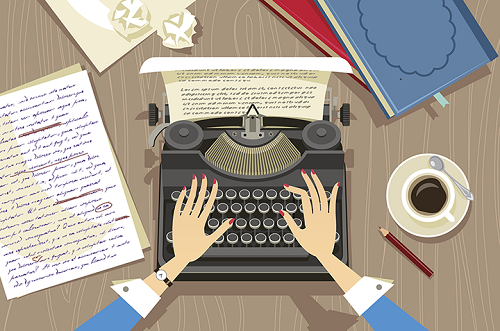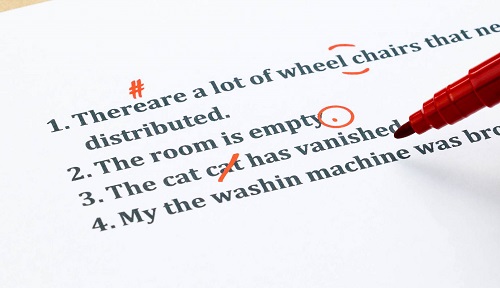How to Edit Your Copy
Editing is an important part of the writing process, and you must cross all your T’s and dot all your I’s during this stage. There are many reasons why you should thoroughly edit your copy. Perhaps the most significant reason is that it prevents or corrects cringe-worthy errors and improves your work’s overall quality.
In this article, we discuss some of the basic elements that go into the editing process. We also highlight some of the common errors that writers make when they produce copy and state a few tips on avoiding making those mistakes.
Different Types of Editing
There isn’t just one simple formula to editing, applicable across the board. Several different types of editing processes exist that may or may not apply to you based on the kind of writing that you do. But, even though different types of editing exist, we can group them all under two main umbrella terms, namely micro and macro editing.
Micro Editing
Micro editing refers to looking at the finer details of a page. It, among other things, considers the company’s AP style or publication and checks if you correctly record names, titles, dates, ages, numbers, dimensions, abbreviations, addresses, monetary values, and symbols. It also checks if your grammar is correct.
Macro Editing
Macro editing takes a broader approach and looks at the page as an individual body of work. Questions you might ask yourself during the macro editing process includes:
- Is the page written, and does it make sense?
- Are the headings and paragraphs structured in chronological order?
- Is all the information stated accurate and true?
If any of the above is not in order, you might have to re-write or restructure your information so that it is.

The Difference Between Copywriting and Editing
Copy editing and proof-reading are two terms used interchangeably when they are two separate stages in the writing process.
Copy editing is meant to happen before the copy is submitted for proof-reading. It falls under macro editing, which means that at this stage, you look for inconsistencies, you re-write, restructure, fact check, ensure that the copy makes sense, is on topic, and includes all relevant information.
Only after the copy has been edited will it move to the proofreader, who will look for typographical errors and correct those. The proofreader works with a duplicate of the finished product. Sometimes, this duplicate is called a “proof.” The role of the proofreader is not to make big changes to the text. Their role is to search for trivial wording and formatting errors to correct. The proof-reading stage signifies the final stage in the editing process and gives the final go-ahead for print or web publishing.
How to Self-Edit Your Work
When an editor or proofreader is not available, you need to be able to edit and sub your own work. It is super important for every writer to take responsibility for the quality of content that they produce. This means learning how to self-edit your own work, so others don’t have to. This is an important part of the writing process that often gets left out.
Here are some tips for editing your page and creating a good copy:
- Treat your page as though it’s bylined with your true identity. Some writers hide behind the safety net of fake names and avatars. But we shouldn’t use this as an excuse to create copy that’s less than the standard required. So, ask yourself – would I be proud of this page if my real name and photo were displayed for all to see?
- Read your page aloud. Reading what you’ve written aloud may seem silly, but it makes all the difference in picking up mistakes. By reading every word aloud, you get to hear what your page will sound like to the reader and if it all makes sense.
- Improve your grammar and word usage. Good grammar really adds to the overall quality of your page, and admittedly, even some of the best writers make grammar mistakes.
Common Grammar Mistakes
Mistakes are inevitable, and all kinds of work are subject to human error. Even the best writers and most esteemed publications make mistakes here and there. And, even though your mistakes aren’t intentional, it can be embarrassing spotting various mistakes in an article or paper that you’ve written. So, here are a few common grammar mistakes to be mindful of and to avoid making.

Lay vs. Lie
This may be an obvious one for all the advanced English readers out there, but it can be confusing to more entry-level or intermediate English speakers. The correct way to use “lay” is in this sentence: Before dinner tonight, I will lay the table with plates and cutlery. Studies say that when you intend to put an object somewhere, you must use the word “lay.”
The correct way to use the term “lie” is in the following sentence: My husband was lying on the couch when I walked into the lounge. Saying ‘my husband was laying on the couch when I walked into the lounge” would be wrong. Lie is an intransitive verb that doesn’t need an object, while lay is a transitive verb that does.
Could of vs. Could Have
This one should be easy to remember. It’s never correct to say could of. It’s always correct to say could have. This is probably one of the understandable grammar mistakes that writers make because the two sound almost exactly the same, and both seem sensible.
Comma Splice Errors
A comma splice is when you join two perfectly independent sentences using a comma and not a full stop/ period or conjunction term. Here are three examples of the correct and incorrect way to use a comma or conjunction when joining two sentences.
Incorrect: She was thirsty. She drank a whole Pepsi.
Correct: She was thirsty; she drank a whole can of Pepsi.
Also correct: She was thirsty, so she drank a whole Pepsi.
Tautologies
A tautology in English refers to saying the same thing twice using words that have different spelling but mean the same thing. I’m certain many of us are guilty of using at least one of these at some point.
- Added bonus
- Each and everyone
- Above and beyond
- Large crowds
- Vast majority
- Close proximity
- A pair of twins
- Armed gunman
- Forward planning
- Necessary requirement

Common Style Guidelines
The majority of publications in the US use the standardized AP style guide as a guideline on how to treat abbreviations, capitalization, symbols, numbers, age, names, dates, dimensions, and more in writing. Here is what the guide says about the following.
Numbers – Digits between one and ten must be spelled out, while numbers from 11 and up can be presented as digits. Some exceptions to this rule include:
- Addresses
- Ages
- Monetary values.
- Dates and times.
- Sizes and dimensions.
- Percent
Age – when you speak about age, it’s always best to write it in digital form. If you are using age as an adjective to describe someone or something, then you must use hyphens. It’s also not correct to use apostrophes when referring to the age range. For example, In my 20s, I was wild and carefree.
Dates, Years, Months, Days – Exact dates and years should always be presented as figures. You must always capitalize the first letter of every month, and only Jan, Feb, Aug, Sept, Oct, Nov, and Dec are accepted as abbreviations.
The use of punctuation in dates is also pretty straightforward. No comma is needed when only a year and month are stated. However, you must use a comma to separate the year from the month and the exact date if that information is given.
Regarding decades and centuries, it’s a common error to put an apostrophe after a decade, for example, the 90’s. But, research shows that this is not correct and should be written as the 90s instead.
Overview
Of course, there’s a lot more that goes into the editing process, and there are many other common mistakes and AP style guidelines to follow when you produce copy. But, for the sake of time and your attention span, we’ve only mentioned the ones above. Remember that at the end of the day, it is your responsibility as a writer to produce copy that is as clean as possible to make the jobs of the editor and proofreader more bearable. Clean copy also adds to your credibility as a writer.
See Other Posts
- Power Words: How to Write the Perfect Meta Title, February 26, 2021
- Google Ads and Quality Score , February 23, 2021
- SXO: Combining SEO and User eXperience, February 18, 2021
- PPC Strategy: Best Ways to Market Your Website, February 16, 2021
- Index Coverage Report – Getting Google to Index your Pages, February 11, 2021


